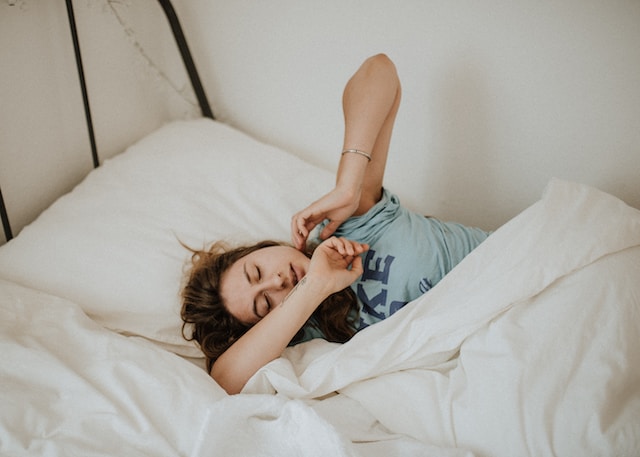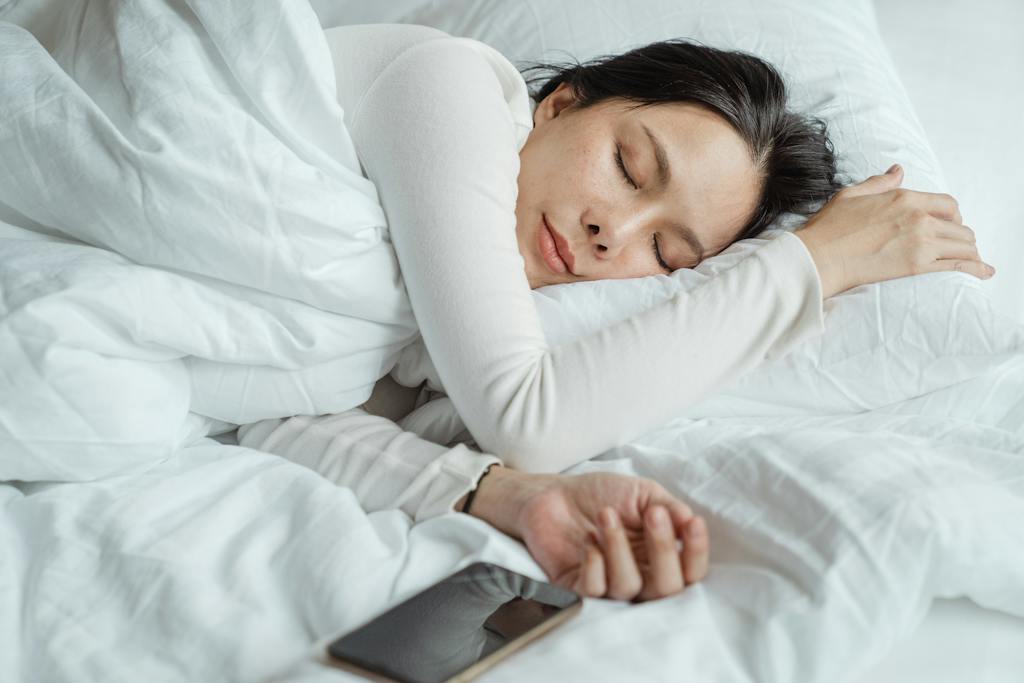Best Sleeping Position for Sinus Drainage: Tips and Tricks
There are some affiliate links below, but they are all products I highly recommend. For more info, view my disclosure here.
Are you tired of waking up with a stuffy nose and sinus pressure? Your sleeping position could be the culprit. The way you position your head and body while sleeping can affect the drainage of your sinuses, which in turn affects your breathing and quality of sleep. We’ll explore the best position for sinus drainage to help you breathe easier and get a good night’s sleep.
The position you sleep in can impact your sinus drainage by either helping or hindering the flow of mucus. When you sleep on your back, gravity can cause mucus to accumulate in your sinuses, leading to congestion and pressure.
On the other hand, sleeping on your stomach can cause your head to be turned to one side, which can block the nasal passages and make it harder to breathe. So, what is the best sleeping position for sinus drainage? Let’s find out.
Understanding Sinus Drainage and Sleep
The Impact of Sinus Issues on Sleep
If you suffer from sinus issues, you know how they can affect your sleep. Sinus infections, sinus pressure, and sinus pain can all make it difficult to get a good night’s sleep. When your sinuses are congested, it can be hard to breathe through your nose, which can lead to snoring and sleep apnea. This can cause you to wake up feeling tired and groggy, even if you slept for a full eight hours.
How Sinus Drainage Affects the Body at Night
During the day, your body is constantly producing mucus to keep your nasal passages moist and clean. But at night, when you lie down, that thick mucus can start to pool in your sinuses, leading to congestion and discomfort.
This can make it difficult to breathe through your nose, which can lead to snoring and sleep apnea. In addition, sinus drainage can cause irritation and inflammation in your nasal passages, which can make it even harder to breathe.
To combat these issues, the best sleep position is a position that promotes sinus drainage. Sleeping with your head elevated can help to prevent mucus from pooling in your sinuses, which can reduce congestion and improve your sleep quality. You can achieve this by using a wedge pillow or by propping up the head of your bed with blocks or books.
Overall, understanding how sinus drainage affects your sleep can help you to make changes that will improve your sleep quality. By sleeping in a position that promotes sinus drainage, you can reduce congestion and irritation, which can lead to a more restful night’s sleep.
Optimal Sleeping Positions for Sinus Relief
If you suffer from sinus congestion, you know how difficult it can be to get a good night’s sleep. Luckily, there are a few sleeping positions that can help alleviate your symptoms and allow you to rest more comfortably.
Elevating the Head to Enhance Drainage
One of the best sleeping positions for sinus relief is to elevate your head. By using an extra pillow or raising the head of your bed slightly, you can promote better blood flow and drainage in your sinuses. This can help reduce nasal congestion and make it easier to breathe.
To elevate your head, simply add an extra pillow or two under your head and neck. Alternatively, you can place blocks or risers under the head of your bed to create a slight incline. This can help keep your sinuses clear and reduce the discomfort associated with congestion.
Sleeping on Your Side to Reduce Congestion
Another effective sleeping position for sinus relief is to sleep on your side. This can help reduce congestion by allowing gravity to pull mucus away from your sinuses and down your throat. Sleeping on your back or stomach can actually make congestion worse by allowing mucus to pool in your sinuses.
To sleep on your side, simply roll onto your left or right side and use a pillow to support your head and neck. This can help keep your airways open and reduce the discomfort associated with congestion.
Overall, the best sleeping position for sinus relief will depend on your individual symptoms and preferences. By elevating your head and sleeping on your side, you can promote better drainage and reduce congestion, allowing you to get a better night’s sleep.
Sleeping Positions – Specific Details
Getting the proper elevation and alignment when you sleep can significantly improve sinus drainage. To elevate your head, use 2-3 pillows to prop your head up at a 30 degree incline. Having your head elevated higher than your chest allows gravity to aid in mucus drainage from your sinuses.
Sleeping on either your left or right side with a pillow between your knees can also promote drainage by keeping one nasal passage clear. Be sure to use an extra pillow under your head for proper support and alignment if sleeping on your side. Avoid sleeping completely flat on your back, as this position often causes mucus to pool and settle into the nasal cavities, leading to congestion.
If using pillows alone does not provide enough incline, try putting blocks or risers under the head of your bed to raise it 4-6 inches. This slight elevation keeps mucus draining downward throughout the night.
Home Remedies and Techniques
If you’re looking to alleviate sinus congestion and improve your sleep quality, there are several home remedies and techniques that you can try. Here are a few options to consider:
Humidifiers and Air Quality
One of the most effective ways to improve sinus drainage while you sleep is to use a cool-mist humidifier. This device adds moisture to the air, which can help to thin out mucus and make it easier to breathe. Be sure to clean your humidifier regularly to prevent the growth of bacteria and mold.
In addition to using a humidifier, you can also take steps to improve the air quality in your bedroom. This may include using an air purifier, keeping your windows open to allow for fresh air circulation, and avoiding smoking or exposure to secondhand smoke.
Nasal Irrigation and Nasal Sprays
Another option to consider is nasal irrigation, which involves flushing out your nasal passages with a saline solution. You can use a neti pot or a squeeze bottle to administer the solution, which can help to remove excess mucus and other irritants.
Saline sprays can also be effective in reducing nasal congestion. These sprays work by moisturizing the nasal passages and reducing inflammation. However, it’s important to use them correctly to avoid damaging the delicate tissues inside your nose.
Other options to consider include nasal strips, which can help to open up your nasal passages and improve airflow, and taking a hot shower before bed to help loosen up mucus and relieve congestion.
By incorporating these home remedies and techniques into your bedtime routine, you can help to alleviate sinus congestion and enjoy a more restful night’s sleep.
Avoid Sleeping on Your Stomach
While sleeping on your side or with your head elevated can aid sinus drainage, sleeping on your stomach is often counterproductive. When you sleep face-down, mucus is allowed to pool in the sinus cavities located on the sides and front of your face. This can lead to congestion and pressure upon waking.
Sleeping on your stomach also requires you to turn your head to one side, which can constrict airflow through the nasal passages. Try to avoid this position if you suffer from sinus issues. Sleeping on your back is also not ideal, as mucus can accumulate without being able to drain properly.
Consider Using a Cervical Pillow
For additional support if you sleep on your side or back, consider investing in a cervical pillow. This type of pillow is contoured to provide alignment for the head, neck, and shoulders. The curved shape allows the head to be slightly elevated while providing comfortable support on the sides.
This alignment allows for optimal drainage down the back of the throat instead of the sinus cavities on the face. A cervical pillow also reduces pressure points that can lead to sinus congestion. With improved alignment and elevation, a cervical pillow can enhance sinus drainage overnight.
Lifestyle Adjustments for Better Sinus Health
If you suffer from sinus issues, you know how uncomfortable and disruptive it can be to your daily life. While there are many medical treatments available, simple lifestyle adjustments can also help improve your sinus health. Here are some tips to consider:
Dietary Considerations
Certain foods can exacerbate sinus issues, while others can help alleviate them. Spicy foods, for example, can cause inflammation and congestion in your sinuses. On the other hand, foods high in vitamin C, such as citrus fruits and leafy greens, can help boost your immune system and reduce inflammation. It’s also important to stay hydrated by drinking plenty of water, as dehydration can worsen sinus issues.
Environmental Factors and Allergens
Environmental factors can also play a role in sinus health. Pet dander, for example, can trigger allergies and worsen sinus symptoms. If you have pets, try to keep them out of your bedroom and vacuum frequently to reduce dander.
Essential oils can also be helpful in reducing inflammation and congestion, but be cautious if you have sensitive skin or allergies. Lastly, seasonal allergies can be a major trigger for sinus issues.
Be aware of pollen counts and try to avoid going outside during peak allergy seasons. Tobacco smoke can also irritate your sinuses, so it’s best to avoid smoking and exposure to secondhand smoke.
By making these simple lifestyle adjustments, you can help improve your sinus health and reduce the frequency and severity of your symptoms.
When to Seek Professional Medical Advice
If you are experiencing chronic sinusitis or nasal polyps, it is important to seek medical advice from a throat doctor or ENT doctor. These conditions can cause significant discomfort and may require medical treatment to manage effectively.
If you experience persistent symptoms, such as facial pain, pressure, or congestion, it may be a sign of a more serious underlying condition. In such cases, it is important to seek medical advice as soon as possible to prevent the condition from worsening.
If you have tried various sleeping positions and home remedies without success, it may be time to consult with a medical professional. They can provide you with personalized guidance on the best sleeping position for your specific needs and offer treatment options to alleviate your symptoms.
If you have persistent sinus infection symptoms such as facial pain or pressure around the cheeks, eyes and forehead, nasal congestion lasting more than 10-14 days, yellow or green nasal discharge, reduced sense of smell, or a cough, sore throat and fever along with sinus pressure. Your doctor can run tests to determine the cause of your symptoms.
Remember, while sleeping in the right position can help with sinus drainage, it is not a substitute for professional medical advice and treatment. If you have concerns about your sinus health, it is always best to consult with a medical professional.






